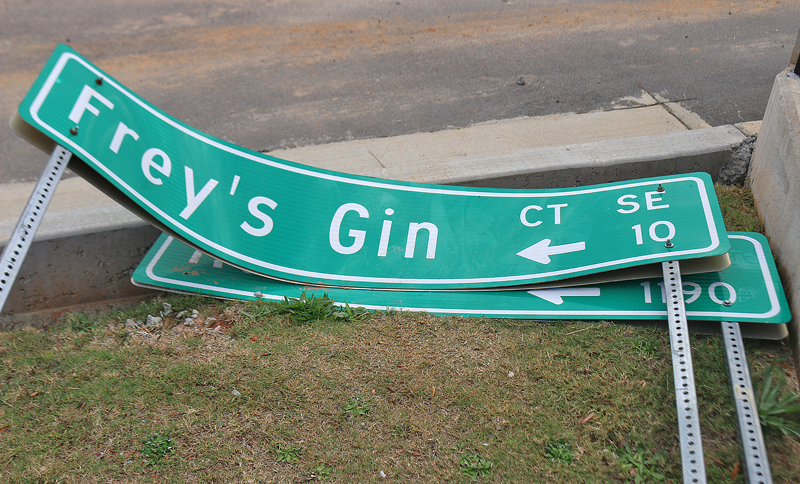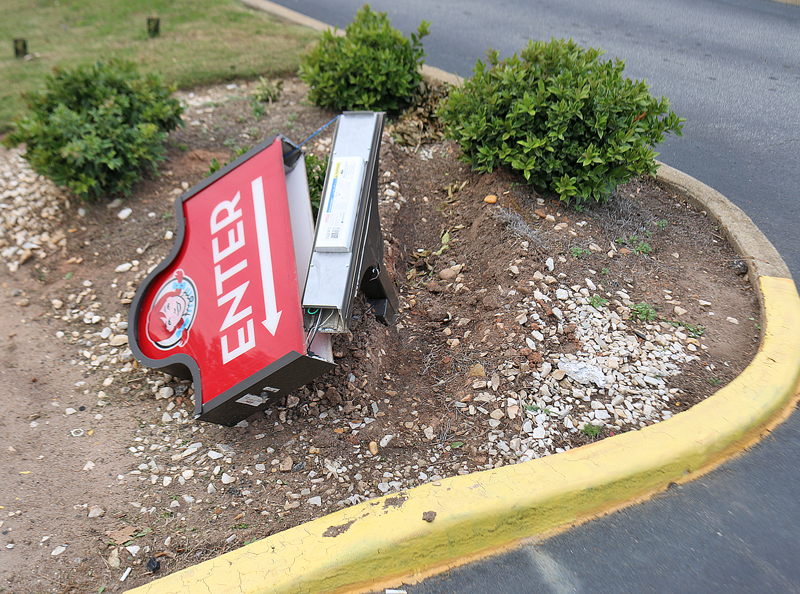Note: This article pertaining to Where Leo Frank Was Lynched 110 Years Ago: Justice — or Anti-Semitism? was originally published on Wednesday, August 19, 2020 at 12:59 in the afternoon and has been updated.
Motorists have been using the new Roswell Road exit of Interstate 75 in Marietta ever since the Northwest Corridor Express toll lanes opened to traffic on Saturday, September 8, 2018 — not realizing that they are passing the spot where many people believe that a historic grave injustice had occurred as they enter and leave the busy highway in Georgia.
Where Leo Frank Was Lynched 110 Years Ago: Justice — or Anti-Semitism?
The strangled body of Mary Phagan — who was only 13 years old — was found near an incinerator in the rear of the basement of the National Pencil Company by the night watchman on Saturday, April 26, 1913.
Leo Max Frank was a Jewish man who is thought to be wrongfully convicted of the murder of a female employee of the pencil factory, of which Frank was a superintendent. Did he attempt to sexually assault Mary Phagan — or did someone else kill her and frame Frank?

The state historical marker of the lynching of Leo Frank which was originally located on the south side of Roswell Road before the new toll lanes were constructed. Near the marker was a mature tree, a K-Mart department store, a Long John Silver’s seafood restaurant, and a Wendy’s fast food hamburger restaurant. A new sign designating the entrance to the toll road remains covered.

Prior to its realignment due to the entrance and exit ramps for the new toll lanes, the bent sign for Frey’s Gin Court lays on top of the sign for Roswell Road.

The temporary orange detour sign is positioned near the spot where the state historical marker was originally erected and located.

Traffic moves along on Interstate 75 above the overpass which crosses over Roswell Road as workers continue construction of the entrance and exit ramp for the Northwest Corridor Express new toll lanes.

A layer of dirt coats the pavement for the old Frey’s Gin Court, which was eventually torn up for construction of the entrance and exit ramp for the new toll lanes of Interstate 75. Even a sign demarcating the entrance to a Wendy’s fast food hamburger restaurant did not escape damage.

The State Historical Marker for the Lynching of Leo Frank Today

Quoted on the state historical marker for the lynching of Leo Frank is the following:
Near this location on August 17, 1915, Leo M. Frank, the Jewish superintendent of the National Pencil Company in Atlanta, was lynched for the murder of thirteen-year-old Mary Phagan, a factory employee. A highly controversial trial fueled by societal tensions and anti-Semitism resulted in a guilty verdict in 1913. After Governor John M. Slaton commuted his sentence from death to life in prison, Frank was kidnapped from the state prison in Milledgeville and taken to Phagan’s hometown of Marietta where he was hanged before a local crowd. Without addressing guilt or innocence, and in recognition of the state’s failure to either protect Frank or bring his killers to justice, he was granted a posthumous pardon in 1986.

A marker located just west of the state historical marker has the following engraved on it:
In respectful memory of the thousands across America, denied justice by lynching; victims of hatred, prejudice, and ignorance.
Between 1880-1946,
~570 Georgians were lynched.ADL
Jewish American Society for Historic Preservation
Rabbi Steven Lebow, Temple Kol Emeth

Excerpted from this article written by Steve Oney for Atlanta magazine is the following statement:
If the judgment of time is the deciding factor, the unit will indeed find Frank innocent. In the years since the April 26, 1913 murder, a consensus has emerged about what happened in Frank’s downtown Atlanta factory that day: The killer was Jim Conley, a black janitor who was the state’s star witness against Frank. While researching And the Dead Shall Rise, my 2003 book on the case, I reached the same conclusion. This is not, of course, how Georgians first saw it. An all-white jury accepted Conley’s word over that of Frank, his Jewish boss, and the judge sentenced Frank to die by hanging.
The spectacle of a Jim Crow–era court relying on a black man’s testimony to convict a white man of murder was remarkable, but the nation remembers the case because of what happened next. Following extensive coverage in the press and appeals that ran all the way to the United States Supreme Court, Governor John Slaton commuted Frank’s death sentence in June 1915. Shortly thereafter, a group of men from Marietta, Phagan’s hometown, abducted Frank from the Georgia prison farm in Milledgeville, drove him to Marietta, and lynched him. Several months later, the Ku Klux Klan, which had disbanded following Reconstruction, reestablished itself at a cross-burning atop Stone Mountain.
The Frank case opened a deep vein of anti-Semitism in America, unleashing furies that remain part of the national psyche. (The Anti-Defamation League was founded in 1913 to combat those furies.) As a result, any discussion of the subject is difficult. Emotions about it run strong, and, while a majority now believes the factory superintendent was guiltless, others resent what they regard as a knee-jerk acceptance of that fact. Howard’s investigators will need to keep this in mind if they are to vindicate Frank. The affair pitted Jew against Gentile, white against black, rural against urban. Regardless of the outcome, not everyone will be happy.

However, Mary Phagan-Kean claimed at her official Internet web site that her great-aunt was indeed killed by Leo Frank:
The Phagan family has no objection to anyone expressing their opinions about the Frank case, but we do insist that organizations and personal campaigns not distort the truth and facts to use this case for their own political purposes. For over 100 years, each passing decade brought with it “new historical evidence” falsely claiming to exonerate Leo Frank. The Phagan family has stated since 1982 that if there were clear-cut evidence to clear Frank of this heinous crime, we would come forward and ask for exoneration. However, such historical evidence has never come to light. Rather, there are considerable data, extensive documentation, revealing archival material, and legal, court, and government records that only support and even strengthen the guilty verdict.

A sign adjacent to the overpass marks the Roswell Road entrance and exit of the Northwest Corridor Express toll lanes of Interstate 75.

The former location of the state historical marker for the lynching of Leo Frank is on the extreme right of the photograph shown above, which is now a ramp for access and egress of motor vehicles from the Northwest Corridor Express toll lanes of Interstate 75.

The state historical marker for the lynching of Leo Frank was eventually moved to a spot on the north side of Roswell Road, as it was erected near the intersection of Halsey Drive and Chert Road in Marietta on the west side of Interstate 75.
No one was ever prosecuted for the kidnapping or lynching of Leo Frank.

Direct access to Roswell Road is no longer possible from Chert Road due to the new spot where the state historical marker for the lynching of Leo Frank was erected — which is located in the wide spot in the concrete walkway after the curve on the left of the photograph — as well as due to the entrance and exit ramp for the new toll lanes of Interstate 75.

Final Boarding Call
The state historical marker for the lynching of Leo Frank is located in Marietta in Georgia on the north side of Roswell Road in Marietta and adjacent to the entrance and exit ramp for the Northwest Corridor Express new toll lanes of Interstate 75.
No official parking spots are designated for the state historical marker for the lynching of Leo Frank — but this is not exactly a place where you will spend the day, so you can park either at the dead end on the southern terminus of Chert Road; or an unused concrete ramp which leads to nowhere is available on the east side of Chert Road next to Interstate 75. You will be within walking and sight distance of your vehicle.
No admission is charged to visit this site, which has no operating hours. No facilities are available either — except at the numerous dining establishments which are nearby if you want to stop for a snack or a meal.
As to whether the lynching of Leo Frank on Tuesday, August 17, 1915 was a verifiable act of justice or simply a brazen act of anti-Semitism, judge for yourself based on both the evidence and conjecture pertaining to the case as presented by this article at Wikipedia — which includes citations if you want to check the sources — as well as the aforementioned article and book by Steve Oney and the statements from Mary Phagan-Kean, which includes this paper of the official position of the Phagan family.
One thing is for certain, as motorists continue to pass by the spot where Leo Frank was lynched: this controversial case represents a dark era in the state of Georgia…
All photographs ©2017 and ©2020 by Brian Cohen.
